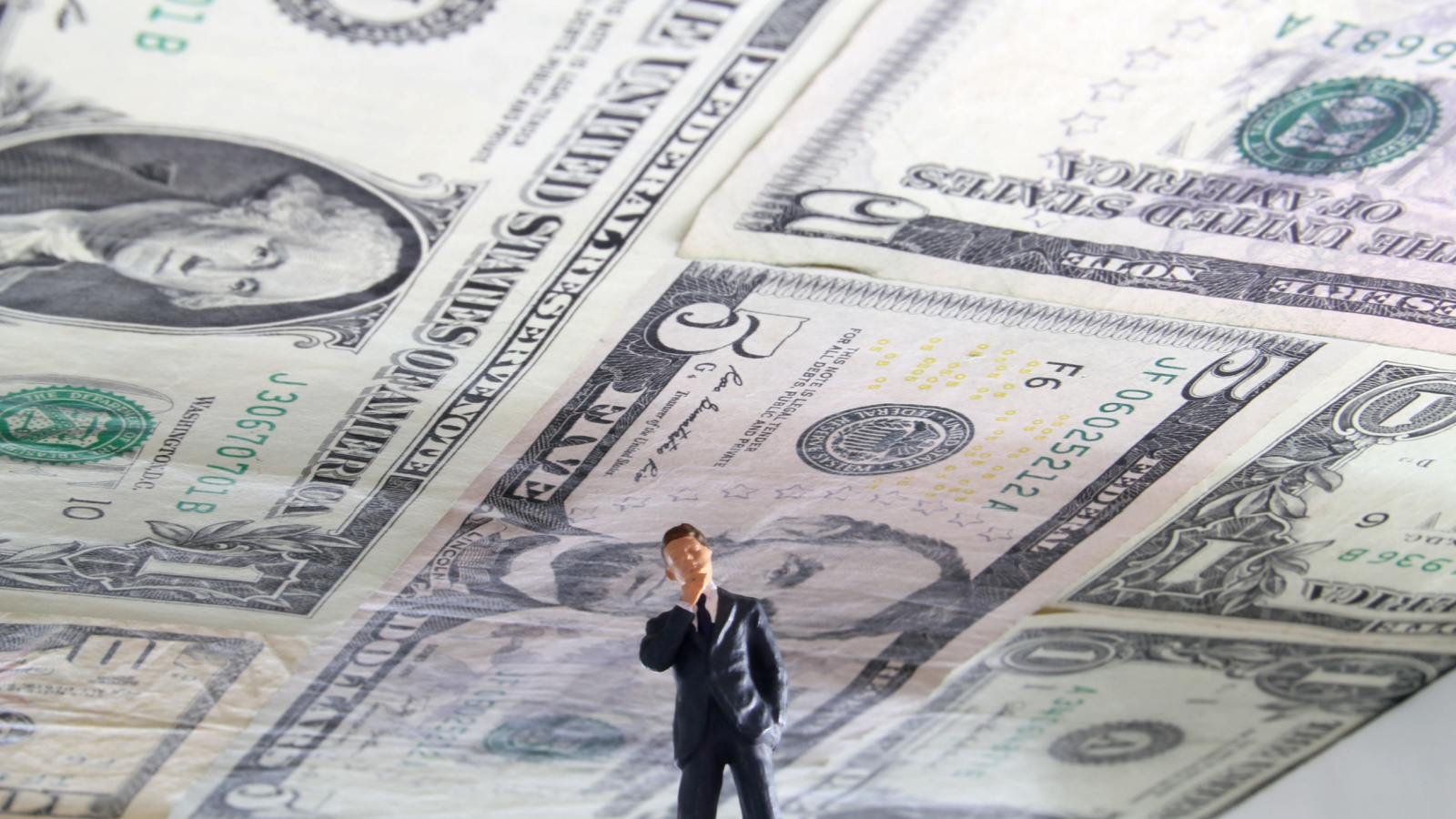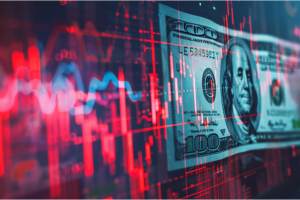
Home sales fall as prices rise … workers are demanding the highest salaries ever … is your personal financial situation getting better? … credit card borrowers can’t pay off their balances
There’s lots happening in the news. Let’s bounce around to a handful of stories impacting your portfolio.
We’ll begin with the housing market.
Yesterday, we learned that home sales fell again in July, and existing home inventory continues dwindling.
Here’s CNBC:
Sales of previously owned homes dropped 2.2% in July from June… Sales were 16.6% lower compared with July of last year. Homes sold at the slowest July pace since 2010…
There were 1.11 million homes for sale at the end of July, 14.6% fewer than July 2022 and about half of the pre-Covid supply.
At the current sales pace, that represents a 3.3-month supply. A 6-month supply is considered balanced between buyer and seller.
As you’d expect, limited supply continues putting pressure on prices. CNBC notes that the median price of a home sold in June was $406,700. That’s up 1.9% from July of last year.
When you look at how many homeowners have low mortgage rates, it makes sense why the housing market is barely registering a heartbeat
Mortgage rates have skyrocketed to more than 7%.
Well, so what?
The only people this is impacting are rich Americans who can afford mortgages at these rates. These rates aren’t denting vulnerable wallets. All they’re doing is constructing a mile-wide protective moat around the existing home sales market.
Below, we look at the percentage share of outstanding mortgages as a function of their respective interest rates. What you’ll see is that 91% of borrowers have mortgages less than 5%. More importantly, a full 70% of outstanding mortgages carry rates less than 4%.

None of those sub-4% homeowners will be selling in today’s market except by necessity. And that means don’t expect home prices to drop…
By extension, inflation should edge higher when these home prices eventually filter into the inflation data.
(We covered this issue of “lag time” between real time home price changes and when those prices show up in the inflation data in our Monday Digest. Click here to revisit it.)
Speaking of inflation data, one of the Fed’s biggest worries is wage inflation, and we just got a doozy of an update on the wages that workers are now demanding
The salary that most workers now want to accept a new job just hit a record high…
$78,645.
This average “reservation wage,” or minimum acceptable salary offer to switch jobs, represents an 8% increase from last year’s reservation wage. It’s also the highest level on record.
Here’s CNBC:
The number is significant in that wages increasingly have been recognized as a driving force in inflation.
While goods prices have abated since pushing overall inflation to its highest level in more than 40 years in mid-2022, other factors continue to keep it well above the Fed’s targeted rate of 2%.
So, are employers paying it?
They’re trying – which is inflationary.
The average salary for a full-time job offer has surged 14% in just one year, now coming in at $69,475.
But these higher salaries aren’t helping workers “get ahead,” they’re just helping them tread water
While reports continue to show that inflation is cooling, remember that inflation can be falling while real-world, sky-high prices clamp down on household budgets.
Forget the CPI and PCE reports for a moment. Do you feel that prices are dropping across the board? Are you seeing more margin in your monthly budget?
My favorite local restaurant has jacked up prices about 25% over the last year… nearly all my streaming television services have hit me with price hikes… so too has my internet provider… after some time off, I looked into getting a golf lesson last week – the price has jumped 40% in roughly one year…
Remember, inflation measures changes in prices. All that slowing inflation means is that prices are continuing to get more expensive – but at a slower rate.
Take food. Yes, food inflation is dropping. But what’s going on with actual prices? Here’s the reality from NerdWallet:
– Food prices rose 4.9% between July 2022 and July 2023.
– The index for food at home (groceries) is 3.6% higher year-over-year.
– Restaurant patrons are still paying more (7.1%) for food than they did a year ago.
Or what about childcare costs?
Here’s The Wall Street Journal:
While overall inflation has fallen significantly since last year, families with young children still face sharp increases in one of their biggest expenses—child care.
The national average price of daycare and preschool services rose 6% in July from a year before, the Labor Department reported recently. That was nearly double the overall inflation rate of 3.2%.
We could go on, but you get the point.
It makes sense why Americans are demanding higher salaries – without them, they’ll sink financially.
To what extent is this “sinking” is already happening?
We’ve all seen the headlines trumpeting the “resilient consumer.” Combine that with how 70% of our economy comes from consumer spending, and most economists now predict we’ll avoid a recession thanks to this surprise resiliency.
Well, earlier this week, the U.S. consumer crossed a dangerous financial threshold and whether those economists are watching, you need to know what just happened.
From Yahoo! Finance:
The share of Americans rolling their credit card debt from month-to-month is for the first time higher than the portion who pay their bill in full, according to a new survey.
J.D. Power found that 51% of Americans can’t pay off their entire balance each month and instead let it revolve to the next month, accruing interest, according to its annual credit card satisfaction survey. The remaining 49% — called transactors — can pay their bill in full each month…
“What we have not seen in the past is there are more revolvers than transactors,” John Cabell, managing director of payments intelligence at J.D. Power, told Yahoo Finance.
“It’s inflation, it’s savings dwindling, we’re also seeing rising interest rates, which makes it harder to pay off that balance because it’s getting bigger.”
Not paying off credit balances unleashes the power of compound interest against the U.S. consumer.
If unchanged, it will eventually result in an exponential credit card debt curve as interest is added to principal, resulting in a greater inability to pay off the principal, which adds more interest, which puts the higher principal amount even farther out of reach…
It’s a debt spiral that ends in a fiery mess. And for the first time ever, most Americans are on this path.
I wonder whether instead of a “resilient” U.S. consumer, we have an “irresponsible” U.S. consumer who refuses to spend less, conditioned to spend more from the halcyon days of pandemic savings excess.
In any case, it’s not sustainable. Meanwhile, the mirage of broad consumer strength is propped up by the financial press in a way that reminds me of the Emperor’s New Clothes.
Now, I don’t know how far we can kick this can down the road, perhaps a long way. But eventually someone pays – whether through loan defaults, personal bankruptcies, financial austerity, or broad inflation.
Even high-income Americans are feeling the financial heat
While they’ll be just fine, the risk is that their growing pessimism results in less spending, hurting the economy.
Here are the details of this pessimism from Bloomberg:
In a nationwide survey of over 1,000 objectively wealthy Americans — defined in this case as making at least $175,000 a year, roughly the amount required to crack the top 10% of US tax filers — a full quarter told us they were either “very poor,” “poor,” or “getting by but things are tight.” Half described themselves as just “comfortable” …
At a time when pretty much everything is more expensive, including cars, tuition, travel and groceries, over half of respondents in our survey said they worry about money.
Some 25% don’t think they’ll be better off financially than their parents. And many have considered moving to a different part of the country, joining the pandemic exodus away from high-cost cities to areas of the US with lower taxes and a cheaper cost of living.
But hey – don’t pay attention to that! Pay attention to the resilient U.S. consumer! And pay attention to how even after the weakness here in August, the S&P is less than 8% from its all-time-high!
Bottom line: Keep riding this bull higher but mind your stop-losses and maintain your investment discipline.
Before we sign off, today is the day that Eric Fry’s “AI Panic” hits the market.
Last week, Eric held a live event that dove into the current state of AI investing. The evening covered lots of ground but focused on a specific event happening today that’s going to shake up the sector, resulting in a “$3 trillion panic.”
In fact, if you’re reading this late afternoon/early evening, the event just happened a couple hours ago.
While I know what this event is, I’m writing Wednesday morning, so I have no idea how it will shake out. But I do know it has the potential to move the entire market tomorrow – possibly in a huge way.
Have a good evening,
Jeff Remsburg





